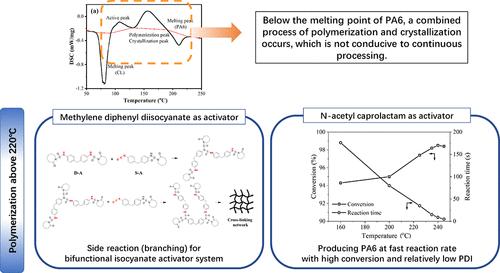Anionic Ring-Opening Polymerization of ε-Caprolactam above the Crystallization Temperature of Polyamide 6: A Study on the Effects of the Activator and Catalyst
IF 3.9
3区 工程技术
Q2 ENGINEERING, CHEMICAL
引用次数: 0
Abstract
The anionic ring-opening polymerization of ε-caprolactam (CL) offers significant potential for producing polyamide 6 (PA6). To establish optimal conditions for designing an efficient and continuous PA6 production process, this study examines the anionic polymerization of CL at temperatures above the crystallization point of PA6. The focus is on the effects of the temperature, activator type and concentration, and catalyst concentration on the polymerization process and product characteristics. At 220 °C, the use of bifunctional methylene diphenyl diisocyanate (MDI) as an activator initiates cross-linking reactions, producing insoluble, nonmelting PA6. In contrast, anionic polymerization without an activator prevents gel formation but results in uncontrollably high molecular weights. The introduction of monofunctional N-acetyl caprolactam (AcCL) as an activator eliminates cross-linking reactions at temperatures above 220 °C while allowing precise control of the product’s molecular weight through adjustments in AcCL concentration.

聚酰胺 6 结晶温度以上的ε-己内酰胺阴离子开环聚合:活化剂和催化剂的影响研究
ε-己内酰胺(CL)的阴离子开环聚合为生产聚酰胺 6(PA6)提供了巨大的潜力。为了建立设计高效、连续 PA6 生产工艺的最佳条件,本研究探讨了在高于 PA6 结晶点的温度下 CL 的阴离子聚合。重点是温度、活化剂类型和浓度以及催化剂浓度对聚合过程和产品特性的影响。在 220 ℃ 下,使用双功能亚甲基二苯基二异氰酸酯 (MDI) 作为活化剂会引发交联反应,生成不溶解、不熔化的 PA6。相比之下,不使用活化剂的阴离子聚合可防止凝胶形成,但会导致无法控制的高分子量。引入单官能团 N-乙酰己内酰胺(AcCL)作为活化剂可消除 220 °C 以上温度下的交联反应,同时还可通过调整 AcCL 的浓度来精确控制产品的分子量。
本文章由计算机程序翻译,如有差异,请以英文原文为准。
求助全文
约1分钟内获得全文
求助全文
来源期刊

Industrial & Engineering Chemistry Research
工程技术-工程:化工
CiteScore
7.40
自引率
7.10%
发文量
1467
审稿时长
2.8 months
期刊介绍:
ndustrial & Engineering Chemistry, with variations in title and format, has been published since 1909 by the American Chemical Society. Industrial & Engineering Chemistry Research is a weekly publication that reports industrial and academic research in the broad fields of applied chemistry and chemical engineering with special focus on fundamentals, processes, and products.
文献相关原料
公司名称
产品信息
阿拉丁
hexafluoroisopropyl alcohol
阿拉丁
Sodium hydride
 求助内容:
求助内容: 应助结果提醒方式:
应助结果提醒方式:


